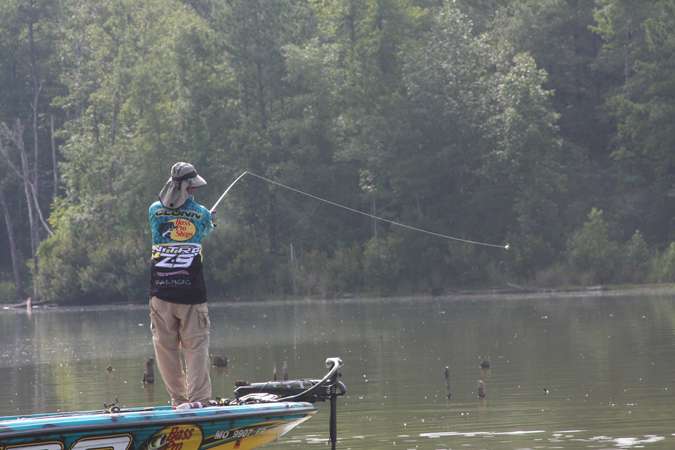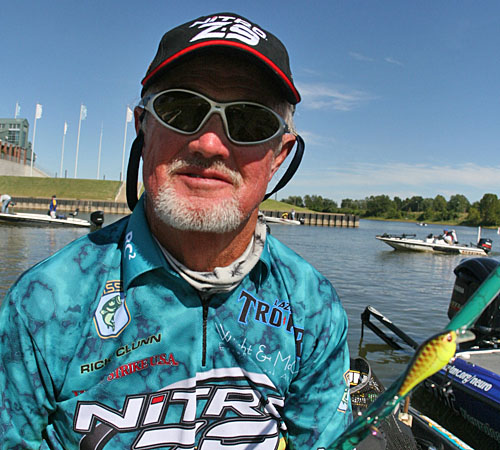
There was a time when Rick Clunn had an advantage in the fall over other bass anglers. He exploited that advantage, too, winning back-to-back Bassmaster Classics in 1976 and 1977, then finishing second in ’78 and third in ’79, when the Classic was a fall event.
“Back then people would fish deeper in the fall because they thought the fish would move deeper with winter coming,” said Clunn, a four-time Bassmaster Classic champion. “But actually there’s a transition from late summer to fall where the fish move shallow again.
“At that time, you could go in the backs of creeks and there would be nobody there. Now people have been educated pretty well.”
Clunn’s favorite lure when the days start getting shorter and the water temperature drops is a square-billed crankbait.
“It’s a bait that I know as well as anybody,” said Clunn, who turned 65 years old in July. “My first Classic was won on a square-bill. A lot of people don’t realize that. They think of it as a new bait.”
Clunn won that 1976 Classic throwing a Bagley Honey B crankbait. Now he favors a Luck-E-Strike Series 1, 2 or 3. The size of the lure is a key. It’s one that Clunn can’t help you with; that decision has to be made on the water.
“The one thing that’s important in the fall is what size bait the fish want,” said the Ava, Mo., resident. “Sometimes they want a big one; the next year they might want a small one.”
The best way to fish a square-billed crankbait has changed over the years. It used to be considered strictly a bait to be thrown at wood cover. Anglers have figured out that bouncing it off rock can trigger a strike just as well.
Clunn advises others to fish the square-bill just like you would a spinnerbait, and don’t be afraid to get it hung up. The flatter head and wider body on the Luck-E-Strike series that he helped design gives the lures a wider wobble and helps them get through cover without hanging up, according to Clunn.
Rick Clunn is armed with a square-billed crankbait.
As for colors in the Luck-E-Strike series, Clunn favors “copper perch” in off-colored water and “snow leopard” (pearl with black and green glitter on the back) in clearer conditions.
Basically, you can’t fish too shallow in the fall, according to Clunn. “So many of these lakes, which are usually low in the fall, will be silted in and most people can’t get through them with big boats,” he said. “Sometimes you need to get over those silted in areas and get back in where the creek channel has still got some depth to it.”
When fishing square bills, Clunn likes a 7-foot fiberglass rod. He believes fiberglass has fish-catching and fish-fighting characteristics that can’t be matched by more modern rod materials.
“I’m tickled to death that a few manufacturers are starting to make fiberglass rods again,” Clunn said. “They never really fell out of favor with the anglers. They fell out of favor with the manufacturers in the late ‘70s when that landslide of high-tech materials came in.”
So what makes fiberglass so special, particularly when fishing crankbaits?
“I could sit here and say it’s the parabolic curve and all that stuff,” Clunn said, “but I don’t know. It’s just the action. It’s just like some square-bills run different, and even though you’ve got three that look just alike, one will catch more fish than the others.
“There’s something about fiberglass that aligns with the mechanics of the way a bass inhales a lure. You hook them deeper.”
Wright & McGill now make a Rick Clunn signature series fiberglass cranking rod. Clunn prefers the “heavy murky water” action.
“If you’re fishing a small bait, you don’t necessarily need it to be that heavy, but I like it, even on a small bait,” Clunn said.
Clunn favors 15-pound test monofilament for square-bills. He might up it to 17 or even 25-pound test with the Luck-E-Strike Series 3, which is a bigger, deeper-running lure.
“Normally, you’re not making long casts when you’re fishing square-bills,” Clunn said. “You’re making short casts and hitting targets. When you’re fishing one- to three-feet deep, you’re not trying to achieve depth. You’re trying to achieve power.”




